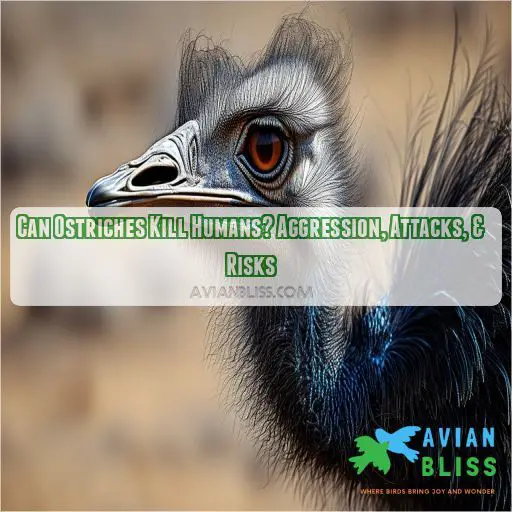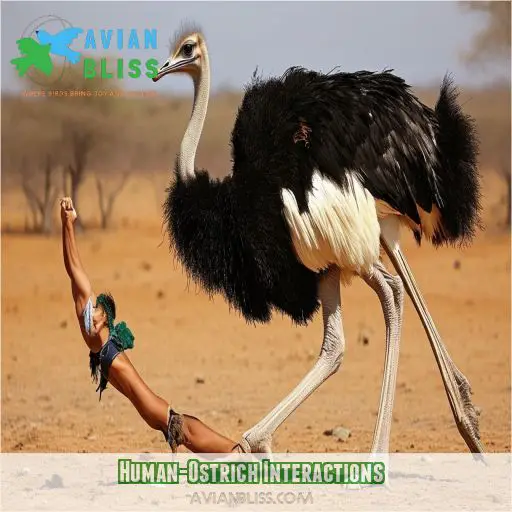This site is supported by our readers. We may earn a commission, at no cost to you, if you purchase through links.

With powerful legs and sharp talons, can their kicks be deadly?
Indeed, an ostrich’s kick packs enough force to kill a human.
These birds are also speedsters, outrunning cheetahs in long-distance sprints.
So, are ostriches a threat to human safety?
This article uncovers the truth, exploring ostrich behavior, aggression, and potential risks to people. **
Table Of Contents
- Key Takeaways
- Can Ostriches Kill Humans?
- Ostrich Behavior Towards Humans
- Understanding Ostrich Aggression
- Ostrich Defense Mechanisms
- Human-Ostrich Interactions
- Ostrich Attacks: Risks and Realities
- Chased by an Ostrich: What to Do
- Coexisting With Ostriches
- Frequently Asked Questions (FAQs)
- Will ostriches attack humans?
- What to do if an ostrich chases you?
- How powerful is an ostrich kick?
- What are ostriches killed for?
- How can humans help protect ostriches?
- How often do ostriches attack humans?
- Are other birds dangerous to humans?
- What are the signs an ostrich feels threatened?
- How far can an ostrich run?
- Conclusion
Key Takeaways
- Ostriches are like feathered tanks, each packing a powerful kick that can prove deadly.
- Don’t be an ostrich with your "head in the sand" – acknowledge their territorial nature, especially during breeding season.
- If an ostrich side-eyes you, don’t try to outrun it; you’ll just become an easy target, a "sitting duck."
- Respect their space and boundaries. It’s their home, and you’re just a visitor.
Can Ostriches Kill Humans?
Yes, ostriches can kill humans.
While typically non-confrontational, ostriches can become aggressive during breeding season or when feeling threatened.
These birds possess powerful kicks, sharp claws, and impressive running speeds, making them a force to be reckoned with.
It is important to know how to react to an aggressive ostrich and what to do if one gives chase.
Continue reading to learn more about the risks of ostrich attacks and how to stay safe.
Ostrich Behavior Towards Humans
Ostriches are typically non-confrontational birds, but they can become more easily provoked during the breeding season. Typically, they roam in pairs or alone, except during this time when they gather in larger groups. The males have distinctive black feathers with white wingtips and tail plumes, while the females sport brown feathers with gray accents.
Native to sub-Saharan Africa and the Horn of Africa, ostriches roam savannahs, deserts, and open woodlands. While they don’t actively prey on humans, they’ll chase them if they feel threatened. It’s important to maintain a safe distance—at least 110 yards—and exercise caution during the breeding season to avoid any potential conflicts.
Understanding Ostrich Aggression
While ostriches are typically non-aggressive, certain factors can trigger their aggression. Understanding these triggers is essential for coexisting safely with these magnificent birds. Here’s what you need to know about ostrich aggression:
- Breeding Season: Ostriches tend to be more easily provoked during their breeding season. This is when they’re protecting their nests and young, so it’s important to exercise caution during this period.
- Provocation: Ostriches generally keep to themselves, but they can become aggressive when threatened or provoked. They may perceive humans as a threat and react defensively.
- Habitat Loss: With their natural habitats shrinking due to development and farming, ostriches may experience increased stress levels, potentially impacting their behavior.
- Conservation Efforts: Protecting ostriches involves addressing habitat loss and illegal activities. The Somali ostrich is listed as vulnerable, highlighting the importance of conservation initiatives.
- Social Behavior: Ostriches are social birds, living in pairs or small groups. Their dynamics can influence behavior, with dominant males and females leading groups during the breeding season.
Ostrich Defense Mechanisms
Ostriches possess formidable defense mechanisms, including powerful kicks that can be lethal. By understanding their physical capabilities and behavioral patterns, you can better assess the risks and learn to avoid confrontations.
Physical Capabilities
Ostriches are the largest, heaviest, and fastest-running birds on the planet. Their long, strong legs, large bodies, and small heads make them formidable runners, reaching speeds of up to 45 mph. Their two-toed feet, with a hoof-like main toe, become formidable weapons when delivering kicks. While their talons may not be as dagger-like as those of a cassowary, their sharp claws can still cause significant damage.
Native to sub-Saharan Africa and the Horn of Africa, ostriches are found in savannahs, deserts, and open woodlands. They tend to be more easily provoked during their breeding season, so it’s important to exercise caution when encountering them in the wild during this time.
Behavioral Patterns
Ostriches are social birds. They typically roam in pairs or small groups. During the breeding season, however, they form larger collections.
Their behavior is influenced by a combination of factors, including their environment and natural predators, such as lions, leopards**, and cheetahs.
These birds are native to sub-Saharan Africa and the Horn of Africa. Here, they make their homes in savannahs, deserts, and open woodlands.
While ostriches are known for their aggressive nature, particularly during the breeding season, their behavior is also shaped by their diet and evolutionary history. The nesting and courtship habits of ostriches also play a role in their propensity for aggression, making them more easily provoked during certain times of the year.
Human-Ostrich Interactions
When interacting with ostriches, avoid confrontations by maintaining a safe distance and staying calm. If an ostrich becomes aggressive, back away carefully and be prepared to protect yourself or find cover.
Avoiding Confrontations
Now that you understand ostrich behavior and their defensive capabilities, let’s discuss strategies for avoiding confrontations with these formidable birds. Here are some key considerations to keep in mind:
- Ostrich Body Language and Habitat Considerations: Ostriches typically roam in pairs or alone, except during the breeding season when they form groups. Males and females have distinct plumage, with males displaying black feathers, white wingtips, and tail plumes, while females sport brown feathers with gray wingtips and plumes. Be extra cautious during the breeding season, as ostriches tend to be more easily provoked during this time.
- Prevention Measures and Seasonal Aggression: Maintain a safe distance of at least 110 yards from ostriches and exercise caution near their habitats, especially during the breeding season. Back away slowly if an ostrich advances toward you, and avoid cornering yourself.
- Breeding Season Risks and Survival Guide: Ostriches are more likely to be aggressive during their breeding season, so be particularly vigilant during this time. If you find yourself in ostrich territory, evaluate the landscape for potential safe cover, such as dense vegetation or structures. Remember, your goal is to avoid close-quarters confrontations and give these birds a wide berth.
Reacting to Ostrich Aggression
If you ever find yourself facing an aggressive ostrich, it’s vital to remember that these birds are powerful and can be extremely dangerous. Your best defense is to avoid confrontation altogether, but if an encounter becomes inevitable, here’s what you need to do:
| Strategy | Action | Reason |
|---|---|---|
| Fighting Back | Use a long object as a weapon. | This will help you keep a safe distance from the ostrich’s powerful legs and talons. |
| Aim for the body, neck, or wings. | Striking these areas can cause enough pain or damage to deter the ostrich. | |
| Keep striking until it retreats. | Ostriches are persistent, so don’t stop until it runs away. | |
| Target the legs to hinder movement. | Disrupting their balance and speed can buy you time to escape. | |
| Evasion | Run for cover. | Dense vegetation or structures can provide a barrier between you and the ostrich. |
| Climb a tree or fence. | Get out of the ostrich’s reach by elevating yourself. | |
| Jump into a thorn bush as a last resort. | The thorns may deter the ostrich from pursuing you further. | |
| Play dead. | This is a desperate move, but ostriches may lose interest if they think you’re no longer a threat. | |
| Prevention | Always keep your distance. | Maintain a safe zone of at least 110 yards between you and the ostrich. |
| Be cautious during breeding season. | Ostriches are more easily provoked during this time. |
Ostrich Attacks: Risks and Realities
Ostriches aren’t typically a threat to humans, but they can become aggressive and dangerous when provoked, especially during their breeding season. With their powerful legs and sharp talons, ostriches can deliver deadly kicks and blows, making them one of the world’s most dangerous birds.
Native to sub-Saharan Africa and the Horn of Africa, ostriches roam savannahs, deserts, and open woodlands, often in pairs or small groups. While they don’t prey on humans, they’ll chase and attack if they feel threatened.
The reality of ostrich attacks is that they’re rare, but they can be extremely dangerous when they occur. It’s important to remember that these birds are wild animals and should be treated with caution and respect.
Chased by an Ostrich: What to Do
If an ostrich chases you, it’s essential to stay calm and plan your escape. Seek nearby cover or use the terrain to your advantage, and avoid sudden movements that could provoke further aggression.
Evasion Strategies
If you ever find yourself chased by an ostrich, your first instinct might be to run. After all, these birds can reach speeds of up to 45 mph, so your best bet is to outrun them, right? Wrong! Trying to outrun an ostrich is a losing battle. Instead, focus on evasive maneuvers that utilize your human advantages.
Ostriches, despite their impressive speed, have limited agility. They can only kick their powerful legs directly in front of them, so use this to your advantage. Try to stay out of their kicking range by keeping a distance of at least 110 yards. If an ostrich does charge, quickly sidestep or dodge to the side. You might also consider climbing a tree, jumping over a fence, or even playing dead as a last resort. Remember, your goal is to avoid becoming a target for their deadly kicks.
Safety Precautions
If you find yourself in the unfortunate situation of being chased by an ostrich, your priority should be to get to safety as quickly as possible. Here are some practical safety precautions to keep in mind:
- Distance is your friend: Maintain a safe distance from ostriches, especially during their breeding season when they may be more easily provoked. A distance of 110 yards is generally considered a safe buffer.
- Don’t corner yourself: When evading an ostrich, avoid running into corners or confined spaces where you may become trapped.
- Know your surroundings: Evaluate the landscape for potential cover, such as dense vegetation or structures that can provide a barrier between you and the ostrich.
- Get creative with evasion: If necessary, be prepared to climb a tree, jump into a thorn bush, or even play dead as a last resort.
Coexisting With Ostriches
Now that you understand how to avoid and react to an ostrich attack, let’s explore ways to coexist with these fascinating birds. Here are some key considerations for peaceful coexistence:
- Ostrich Social Hierarchy: Understand their social dynamics and the roles of alpha males and dominant hens within the herd.
- Breeding Patterns: Be mindful of their breeding season, as ostriches may be more easily provoked during this time.
- Habitat Conservation: Support landscape conservation efforts to ensure ostriches have ample space to thrive.
- Tourism Impact: Encourage responsible and ethical ostrich tourism, benefiting local communities and contributing to conservation.
- Farming Practices: Practice and promote ethical ostrich farming for sustainable meat, feather, and egg production.
Frequently Asked Questions (FAQs)
Will ostriches attack humans?
Ostriches will chase humans when they feel threatened, but they don’t prey on people. Attacks are rare, but ostriches can injure or kill when provoked.
What to do if an ostrich chases you?
If an ostrich chases you, run for cover. If there’s no cover, climb a tree or fence. If you must fight, use a long weapon and aim for the legs, neck or wings.
How powerful is an ostrich kick?
Ostrich kicks are powerful enough to kill a human or a large predator like a lion. With long, sharp claws on each two-toed foot, an ostrich can gore and savage a human with repeated kicks. So, can you outrun an ostrich?
What are ostriches killed for?
Ostriches are killed for their feathers, meat, and skin. They’re also poached for illegal trade and tourist activities.
How can humans help protect ostriches?
To protect ostriches, humans should aspire for peaceful coexistence. This means understanding their behaviour, triggers for aggression, and maintaining a safe distance. Respect their space, avoid provocation, and treat them as wild animals.
How often do ostriches attack humans?
Ostriches rarely attack humans, but when they do, it’s usually because they’ve been provoked. A kick from an ostrich can deliver 500 psi of force, which is enough to kill a human.
Are other birds dangerous to humans?
Yes, several other birds pose a danger to humans. For instance, the Australian Magpie becomes aggressive during breeding season, attacking anything it perceives as a threat, including humans. The hooded pitohui is the world’s most poisonous bird, secreting a toxin that can kill an adult human.
What are the signs an ostrich feels threatened?
If an ostrich feels threatened, it may fluff its feathers, lower its head, spread its wings, or hiss. It’s best to slowly back away and give the ostrich space.
How far can an ostrich run?
You’re wondering how far an ostrich can run, huh? Well, buckle up because these birds can cover some serious ground. While there’s no exact data, ostriches can maintain speeds of 30-31 mph, with peaks at 43-45 mph. That’s a lot of ground covered in a short time.
Conclusion
Ostriches are formidable birds. Their powerful legs and speed make them a force to be reckoned with.
While their kicks can be deadly, understanding their behavior and taking necessary precautions will ensure your safety.
Knowing how to react to an aggressive ostrich and implementing effective evasion strategies are critical.
When faced with an ostrich, remember: coexistence is key. Respect their space and follow safety guidelines to minimize the risk of confrontation.










